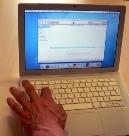Pennsylvania's "Classrooms for the Future" Program Increases
Two hundred-twenty-five more high schools will benefit from Pennsylvania's innovative Classrooms for the Future technology initiative this school year, bringing the total number of participating high schools to 358.
The expansion of the program means high school students in 303 of the state's 501 school districts will be able to begin using laptop computers and other high-tech tools to improve their learning and better prepare for future success.
"Classrooms for the Future is helping our high school students engage in learning on a new level," Governor Edward G. Rendell said. "The new technology will nurture students' minds and feed their appetite for learning and it will prepare them to use equipment and machines that are commonplace in colleges and universities, corporate offices, production plants and just about anywhere they will go after graduating.
"By using technology as a learning tool, we are ensuring Pennsylvania's workforce will remain relevant and competitive in the global economy."
Classrooms for the Future is a three-year investment to provide laptop computers, high-speed Internet access and state-of-the-art software to high school classrooms across the state. Under Rendell's plan, every high school would be part of Classrooms for the Future by 2009.
The 2007-08 budget signed by Rendell in July allocates $90 million to provide the 255 high schools with 83,000 laptop computers and related equipment. It also invests $11 million in high-quality professional development for 12,100 teachers in new Classrooms for the Future high schools. That money, coupled with $2 million in federal funds, will enable each Classrooms for the Future high school to receive $30,000 for staff development.
Education Secretary Gerald L. Zahorchak said professional development is crucial to the success of Classrooms for the Future. As teachers learn how to integrate the technology into classroom instruction, they can move beyond being a mere lecturer and facilitate student-driven work.
The technology is being used in math, science, English and social studies classes to broaden the learning possibilities for Pennsylvania students and provide an unprecedented "gateway" to information and knowledge, the secretary added.
"After only one year, Classrooms for the Future already has proven to be a success for students and educators," Zahorchak said. "Teachers tell us students are more excited and engaged because of these new learning tools. In some cases, truancy and absenteeism are declining."
Greater student engagement is not the only benefit, he noted. Classrooms for the Future helps students connect their academic coursework to the real world, giving deeper meaning to what goes on both inside and outside the classroom.
As examples, the secretary cited a current events teacher who used Classrooms for the Future equipment to help her students stage a videoconference with a soldier serving in Iraq. In another classroom, a group of students studying bridge design used computer software to not only design structures but also to test them to determine whether they would work in a real-life application.
Such activities move students beyond being passive listeners and make them into active learners, Zahorchak said, while the professional development component of Classrooms for the Future ensures teachers are prepared to integrate high-technology into classroom instruction and activities.

No comments:
Post a Comment